Abstract
The social cognitive perspective on socioeconomic status (SES) or social class assumes that SES is associated with people’s perception of social events. The study extends this assumption to SES differences in problem attributions. We hypothesized that compared to lower-class individuals, upper-class individuals will be inclined to attribute the cause of problem situations as being internal, changeable, and controllable and as something for which they are personally responsible for the solution. We further hypothesized that this relationship would be mediated by the individual’s sense of control. Self-report data and responses to vignettes were collected from a sample of Chinese university students. The results and mediation analysis support the hypotheses. The results provide further evidence for social cognitive consequences of SES and point to the important role of sense of control.
PUBLIC INTEREST STATEMENT
Do people from low and high socioeconomic status groups perceive problem situations differently? Perceptions of how the problems come about and of whether one is responsible for finding a solution may impact how individuals manage the problem. This study found that individuals who view themselves as being relatively well-off tend to feel more in control of their life in general, which in turn, relates to their focus on problem causes that are internal (i.e. individual characteristics), changeable and controllable, and see the self as responsible for dealing with their own problem. In contrast, those who view themselves as being less well-off tend to feel less control, which relates to their perceptions of problems as being externally caused, unchangeable, uncontrollable, and of themselves as less responsible for the problem solutions. The results provide further evidence for how people from different socioeconomic groups may perceive social experiences in different ways.
Competing interests
The authors declare no competing interests.
The manner in which people respond to and handle problems often depends on how they perceive these problems. In light of recent research that shows distinct social cognitive tendencies between individuals from different socioeconomic status (SES) groups or social classes (Grossman & Varnum, Citation2010; Kraus & Keltner, Citation2013), is it possible that persons from high and low SES groups perceive problems in dissimilar ways? In this study, we inquire into SES differences in how people view problems and into the mediating role of sense of control in these differences. In the following sections, we first briefly consider how social class and SES have been defined and studied in recent psychology research. We then proceed to examine how different SES group experiences relate to distinctions in sense of control and related cognitive tendencies, and in doing so provide the premises for the hypotheses we test in the study.
Social class is typically studied as a categorical or grouping variable using measures that objectively define social class or SES by referring to a range of measurable variables such as the individual’s level of education, income, and occupation, among others (Bradly & Corwyn, Citation2002; DiMaggio, Citation2012). But psychologists also study social class as a personal experience that refers to an individual’s subjective ranking of the self as compared to others (Kraus, Piff, & Keltner, Citation2011); in this case social class or SES can also be seen as a continuous variable. These subjective ranks typically refer to three aspects: education, income, and occupation (Adler, Epel, Castellazzo, & Ickovics, Citation2000). This subjective measure of SES tends to correlate well with objective measures (Adler et al., Citation2000) and also predicts some important differences in social cognitive processes (Grossman & Varnum, Citation2010; Kraus, Horberg, Goetz, & Keltner, Citation2011). In this study, we refer to SES using both objective and subjective measures.
1. Social class and social cognitive tendencies
The social cognitive perspective (Kraus, Piff, Mendoza-Denton, Rheinschmidt, & Keltner, Citation2012; Kraus & Stephens, Citation2012) suggests that distinct cognitive tendencies arise from the different SES contexts, including and aside from those differences related to parenting. Those from lower SES contexts have to deal with scarcity in material resources, uncertainty, and unpredictability. Such context may give rise to what is referred to as contextualist social cognitive tendencies wherein the individual leans toward external factors, constraints, threats and other individuals when perceiving and trying to understand situations and behaviors (Kraus et al., Citation2012). Growing up in their environment, lower SES individuals may come to realize that survival and living requires looking beyond themselves, and that being effective in their environment requires being sensitive to and managing relations with other people. In contrast, higher SES individuals have easier access to material and social resources. The context of higher class individuals cultivates a sense of individuality and agency over their life and that of others. These life circumstances create solipsistic social cognitive tendencies that orient the person towards individual internal factors including states, goals, and emotions in perceiving and explaining individual actions and social events (Kraus et al., Citation2012).
The social cognitive perspective in social class (Kraus & Stephens, Citation2012) argues that these class-related social cognitive tendencies result in differences in self-conception in terms of how much control one has over one’s life and in construing other people’s actions and the social environment which can be in the form of attributions.
1.1. SES, sense of control and social explanation
SES defines an individual’s life options—options about where to live, study, work, and even who becomes part of one’s social circle. For example, SES can determine whether a student is able to pursue postsecondary education (Davies & Guppy, Citation2013), and to attend more prestigious higher education institutions (Pizarro Milian, Citation2016; Zhou, Cai, & Wang, Citation2016) that are known to secure students higher prospect for employment (Pizarro Milian & Hicks, Citation2014). Generally, individuals from higher SES groups have more and better choices and opportunities for education and for most other things in life; and having choices in one’s social environment fosters a stronger sense of control over one’s life (Ross & Mirowsky, Citation2013). Indeed, empirical research shows that there are significant SES differences in the level of sense of control. Sense of control is a generalized belief about who or what determines situations and actions; whether or not the self can achieve goals and impact the environment (Lachman & Weaver, Citation1998; Ross & Mirowsky, Citation2013). Sense of control may be pervasive in different aspects of an individual’s life and may influence the way he/she interpret or form specific attributions about day to day social situations, particularly problematic ones. Individuals from SES groups who experience reduced resources and subordinate rank tend to experience diminished sense of control (Kraus, Piff, & Keltner, Citation2009; Lachman & Weaver, Citation1998; Snibbe & Markus, Citation2005). In addition, variation in childrearing in families from different SES may also shape people’s perspective of how much control they have over their circumstances (Lareau, Citation2002).
Understanding how sense of control can develop differently is an important area of research as the belief in one’s sense of control over life circumstances and outcomes has been linked to health and well-being (Jang, Chiriboga, & Small, Citation2008; Lachman & Weaver, Citation1998) and, as we propose in this investigation, may determine how individuals perceive problem situations. Kraus et al. (Citation2009) found that sense of control mediated the relation between SES and social explanation. While only Kraus and colleagues looked at the mediating role of sense of control, other studies have consistently shown SES differences in social explanation. In general, lower SES individuals score higher in situational attributions when explaining another person’s actions (Grossman & Varnum, Citation2010) and believe that socioeconomic status is socially constructed (Kraus & Keltner, Citation2013). They also adhere to contextualist explanations for economic disparity, for various positive and negative social outcomes (e.g. getting into medical school, being laid-off at work, having low income) and for other people’s emotions (Kraus et al., Citation2009). Higher SES individuals, on the other hand, prefer dispositional explanations for people’s behavior (Grossman & Varnum, Citation2010), score high in essentialism believing that SES is based on genetic differences (Kraus & Keltner, Citation2013), and tend to have higher individualistic tendency (i.e. seeing themselves as independent from and having more impact on others; Takemura, Hamamura, Guan, & Suzuki, Citation2016). In sum, low SES context exposes individuals to hardships and difficulties that may lower their sense of control which in turn makes them focus more on external factors in explaining behaviors and situations. On the other hand, high SES context allows more freedom and choices leading to higher sense of control, which in turn predisposes individuals to look into internal factors when perceiving social situations and other people’s actions.
The abovementioned studies focused on SES differences in how individuals perceive other people’s behavior or social situations involving others. The current study sought to explore how individuals of different socioeconomic status attribute the problems that they themselves encounter. As will be discussed in the following section, individuals make varying attributions depending on whether they are evaluating their own behavior or those of others.
2. Problem attribution and SES
We propose to extend the implications of social-class related social cognitive tendencies to basic tendencies related to general problem attributions; that is, attributions of problem situations that involve only oneself, and do not involve other social actors. According to attribution theory, when individuals face problem situations, they naturally seek explanations and look for factors that may have caused the situation (Petri & Govern, Citation2013). The attributions that people make have three dimensions: locus, stability, and controllability (Weiner, Citation2010). Locus refer to the location of the source of the problem, whether caused by the self (internal) or others (external). Stability pertains to whether or not it is possible to change the cause in the future (unstable or stable). Controllability relates to whether or not the person has control over the source of the problem (controllable or uncontrollable).
Corroborating Weiner’s attribution theory, a number of studies (e.g. Russell, McAuley, & Tarico, Citation1987; Van Overwalle, Citation1989) have found that people generally agree on the location of certain causes of failures or problems (e.g. intelligence, effort, luck, etc.) in terms of the three dimensions. For example, looking at possible causes of exam outcomes, adolescent students may view intelligence as internal and stable but beyond one’s control, whereas subject difficulty is external, unstable, and uncontrollable (Van Overwalle, Citation1989). The perceived level of the dimensions of the identified cause can influence the person’s affect and motivation for future performance (e.g. internal controllable causes of failure is linked with guilt and regret; Weiner, Citation2010). Brickman et al. (Citation1982) suggest that these types of attributions also relate to how people make attributions about whether they themselves or others are responsible for solving the problem; in turn, this attribution for responsibility motivate people’s action in solving the problem.
Applying the social cognitive tendencies associated with higher and lower SES groups, we would expect that higher SES individuals who have the solipsistic social cognitive tendency, would more likely attribute problems as being internal, changeable, controllable and within their personal responsibility, while lower SES individuals who have the contextualist social cognitive tendency would more likely attribute problems as being external, unchangeable, uncontrollable and the solution being beyond their personal responsibility. However, there are known biases in attribution particularly as it relates to oneself. One well-studied phenomenon is the self-serving bias (Heider, Citation1958; Mezulis, Abramson, Hyde, & Hankin, Citation2004). In order to protect their self-worth, people tend to deny blame themselves for personal failures but claim credit for successes. Related to this tendency is the actor-observer bias, or the tendency to assume internal attributions of others’ behavior but making situational attributions of our own behavior particularly in problem situations (Jones & Nisbett, Citation1972; Malle, Knobe, & Nelson, Citation2007). Thus, the predictions of social cognitive tendencies associated with SES might be undermined if the attribution relates to problems that one is personally facing compared to when the problem involves other people. The current study explores how the social cognitive perspective on social class applies when the focus is on explaining or making attributions regarding problem situations that involve the self.
3. The current study
We tested the assumptions of the social cognitive perspective on SES differences as applied to how individuals perceive problems in their own lives. In doing so, we hope to contribute further evidence regarding SES differences in social cognitive tendencies to a social cognitive function that has not been previously studied in this subarea of research. The further evidence we hope to contribute relates to personal problems, and not social or interpersonal problems. We test the proposition that people from upper and lower SES groups differ in their level of sense of control, which then relates to the degree to which they would consider contextual vs. personal factors in attributions about problems and responsibility for solutions to these problems that they themselves face. The following three hypotheses were derived from the theoretical assumptions presented above:
1. SES of individuals will be positively associated with the individual’s sense of control.
2. SES of individuals will be associated with problem attributions:
higher SES will be associated with more internal, unstable (changeable) and controllable attribution of cause whereas lower SES will be associated with more external, stable (unchangeable) attribution of cause;
higher SES will be associated with attribution of higher personal responsibility for solving the problem while lower SES will be associated with lower personal responsibility.
3. The relationships between SES and problem attributions of locus, stability, control, and responsibility for solution will be mediated by sense of control (as shown in Figure ).
Figure 1. Hypothesized mediation model of the relations among SES, sense of control and attributions regarding the cause of the problem and responsibility for the solution.
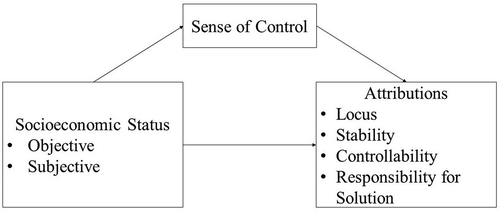
We tested our hypotheses with a sample of Chinese university students from Macau, a special administrative region of China. We used both objective and subjective measures of SES as continuous variables to test the hypotheses. The people of Macau are one of the wealthiest in the world, ranked third highest GDP per capita in the world (2016 estimate US$96,100). But income inequality is relatively high, the most recent GINI coefficient estimate in 2013 is .38, which is very near “alarming” level (≥ .40). Thus, there are likely to be SES differences within Macau society, even as the population as a whole is relatively wealthy.
4. Method
4.1. Participants and procedures
Participants were 347 (135 male, 222 female) undergraduate students recruited through a research participants pool at a university. They were 18–24 years (M = 19.23, SD = 1.29) and gave their informed consent prior to participating in the online surveys. Students completed the online survey on their own time. All participants were given course credit for their participation.
4.2. Measures
The scales used were originally developed in English and were translated to traditional Chinese. Trained research assistants fluent in both Cantonese, the primary language in Macau, and English translated and back-translated the scales following Brislin’s (Citation1986) translation model. Discrepancies in translation were later discussed and corrected based on consensus. Participants first answered the SES questions, followed by the sense of control scale, and finally the attributions questionnaire.
4.2.1. Socioeconomic status
For objective SES, participants reported their parents’ highest educational attainment on a scale from 1 (did not complete primary education) to 7 (doctoral degree or equivalent) and answered the Household Possessions Index (OECD, Citation2012) which served as an indicator of family wealth. The Household Possessions Index is comprised of two questions about whether the individual’s family possess a list of specific items or amenities that are known to be correlated to wealth in various countries (e.g. a room of your own, cars) and some items that are country-specific indicator of wealth (e.g. a digital camera [not including mobile phone camera] for Macau). Respondents answer yes (1) or no (0) for the first question, and from 0 to 3 (possess 3 or more of the item) for the second question. The score is computed as a ratio between the sum of the responses and the total highest possible score for the whole index and scores can range between 0 and 1. Following prior work (Kraus et al., Citation2009), a composite measure of overall objective SES was computed by summing the standardized scores of each of the measures. Negative values indicate lower objective SES compared to the sample mean (i.e. 0) and vice versa. See Table for the correlations of the three measures and the Cronbach’s α.
Table 1. Means (M), Standard Deviations (SD), Reliabilities (α) and Correlations among Study Variables
Subjective SES was measured using the MacArthur Scale of Subjective SES (Adler et al., Citation2000). Participants were asked to rank their family in comparison to others in the city (Macau) in terms of parental income, educational attainment, and occupational prestige using a picture of a ladder numbered from 1 (lowest) to 10 (highest).
4.2.2. Sense of control
Participants answered the 12-item Sense of Control Scale (Lachman & Weaver, Citation1998) using a scale from 1 (strongly disagree) to 7 (strongly agree). The scale had two dimensions: personal mastery and perceived constraints. Personal mastery refers to the individual’s belief that he or she can effectively accomplish his or her goals. Perceived constraints pertains to the person’s beliefs about the existence of uncontrollable factors that can hinder one in achieving his or her goals. To measure overall sense of control, the perceived constraints scale is reverse scored, and both scales are standardized and summed. Higher scores indicate higher sense of control.
4.2.3. Attributions
Participants read five vignettes containing hypothetical problem situations relevant to their life stage (e.g. failing in an exam) and were asked to give a possible cause for each situation. They then answered questions pertaining to their attributions regarding the cause and solution to the situations which were adapted from the Attributional Style Questionnaire (Peterson et al., Citation1982). Using a scale of 1–7 participants were asked to rate the cause of the problem as: (1) whether it was due to other people or circumstances or totally due to the self (locus); (2) whether it is changeable or not (stability); and (3) whether it can be controlled by the person or not (controllability). Participants also rated whether he or she is personally responsible for creating a solution or not using a scale of 1 (self is not responsible) to 7 (self is responsible). Responses for the specific items for each situation were averaged to form the separate scores for attribution of locus, stability and controllability of the cause of the problem and responsibility for solution. Higher scores indicate internal, unstable (changeable) and controllable attributions for problem cause and higher assumed responsibility for solving the problem. Lower scores indicate external, stable (unchangeable), and uncontrollable problem causes and lower responsibility for creating solutions to the problem.
5. Results
Means, standard deviations, reliabilities and the correlations are displayed in Table . The correlations support the first hypothesis; both objective and subjective SES were positively correlated with sense of control (p = .003 and .0001 respectively). Using the benchmarks suggested by Bosco, Aguinis, Singh, Field, and Pierce (Citation2015), we should note that the correlation of sense of control with subjective SES was moderate in effect size, whereas the correlation with objective SES was only small. The correlations also show that age was associated with objective SES (p = .0001) and sex was associated with subjective SES (p = .0001) but neither were correlated with the outcome variables. Age and sex were thus entered as control variables in the main analyses.
The correlations only provide partial support for the second hypothesis; although subjective SES was positively correlated with each of the attribution dimensions, objective SES was only positively correlated with locus and responsibility for solution. We should also note that the effect sizes for the correlations were all small (Bosco et al., Citation2015).
5.1. Predicting sense of control and attributions from SES
A series of hierarchical linear regressions were conducted to further test hypotheses 1 and 2 with sense of control and each of the attribution variables (locus, stability, controllability, and responsibility for solution) as outcome variables and objective and subjective SES as predictors. Age and sex were included as control variables. Relevant assumptions of this statistical analysis (Field, Citation2018) were first tested before running each analysis. The sample size of 347 is deemed sufficient for the analyses with four predictors included (Tabachnick & Fidell, Citation2001). As expected, the correlations (Table ) indicate that objective and subjective SES were moderately associated. Age and sex were also associated with objective and subjective SES, respectively. Collinearity diagnostics indicate, however, that the Tolerance and VIF values were within acceptable limits. The assumption of no perfect multicollinearity was therefore met. Examination of the standardized residuals showed that only 5% or less of the cases were beyond 2 standard deviations and Cook’s distance of all cases were within the limit indicating that there are no influential cases that may bias the models being tested. Graphs of the standardized predicted values and residuals (scatterplot, histogram and normal probability plot) showed that the assumptions of homoscedasticity, linearity, and normality of residuals were all met.
For each outcome variable, a two-stage hierarchical multiple linear regression was conducted. Control variables (age and sex) were entered in block 1 and the predictor variables (objective and subjective SES) in block 2 using forced entry method (enter method in SPSS). This procedure was conducted to explore the amount of variance explained in each of the outcome variables by the predictor variables after accounting for the control variables. Regression statistics are presented in Table –.
Table 2. Summary of Hierarchical Regression Analysis for Variables Predicting Sense of Control
Table 3. Summary of Hierarchical Regression Analyses for Variables Predicting Attributions
Table 4. Summary of Hierarchical Regression Analysis for Variables Predicting Attribution of Responsibility for Solution
The hierarchical regression statistics indicated that SES contributed significantly to the regression model predicting sense of control, ∆R2 = .068, F for ∆R2 (4, 335) = 12.283, p = .0001 (see Table ), after the control variables were accounted for. Age and sex did not significantly predict sense of control. Objective and subjective SES accounted for 6.8% of the variation in sense of control. However, only subjective SES was a significant positive predictor of sense of control (β = .233, p = .004).
Results for attributions (Tables and ) indicated that, after accounting for the control variables, SES contributed significantly to the regression models predicting attributions of problem stability, ∆R2 = .027, F for ∆R2 (4, 335) = 4.648, p = .010, and responsibility for solution, ∆R2 = .031, F for ∆R2 (4, 335) = 5.384, p = .005, but not attributions of locus and controllability. SES accounted for 2.7% of the variance in attribution of stability and 3.1% of the variance in attribution of responsibility for solution. Again, only subjective SES significant positively predicted attributions of stability (β = .142, p = .049) and responsibility for solution (β = .150, p = .029).
Although objective and subjective SES are closely related, the findings show that an individual’s subjective evaluation of socio-economic rank may have stronger association with psychosocial outcomes consistent with previous studies (Kraus et al., Citation2009; Lachman & Weaver, Citation1998).
5.2. Indirect effect of SES on attributions through sense of control
To test the hypothesized mediation model (hypothesis 3), separate mediation analyses were conducted for subjective and objective SES and for each dimension of problem attributions. Using PROCESS macro for SPSS by Hayes (Citation2013), mediation analyses with bootstrapping using percentile method with 10,000 samples were ran to test for indirect effect of SES on each form of problem attributions with sense of control as mediator. As noted earlier, age and sex were correlated with SES and were therefore statistically controlled in the analyses. All coefficients (b) reported are unstandardized. The results for both objective (Figures –) and subjective SES (Figures –) were fairly consistent with each other with some exceptions (i.e. relation with attribution of controllability and strength of relationship).
Figure 2. Objective SES predict attribution for the locus of the problem cause through sense of control. Coefficients are shown with standard error in parentheses. Percentile bootstrapped 95% confidence intervals for the direct effect are indicated in brackets. Coefficients are significant if p < .05.
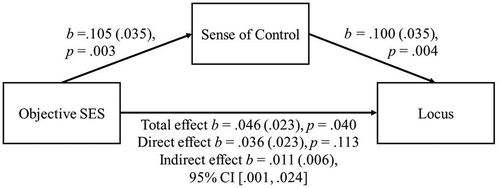
Figure 3. Objective SES predict attribution for the perceived stability of the problem cause through sense of control. Coefficients are shown with standard error in parentheses. Percentile bootstrapped 95% confidence intervals for the direct effect are indicated in brackets. Coefficients are significant if p < .05.
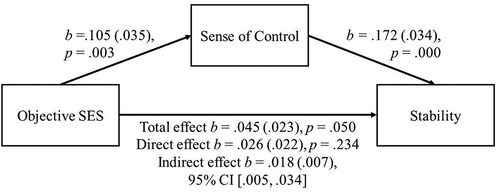
Figure 4. Objective SES predict attribution for the perceived controllability of the problem cause through sense of control. Coefficients are shown with standard error in parentheses. Percentile bootstrapped 95% confidence intervals for the direct effect are indicated in brackets. Coefficients are significant if p < .05.
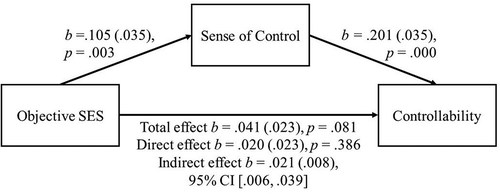
Figure 5. Objective SES predict attribution for the perceived responsibility for the solution through sense of control. Coefficients are shown with standard error in parentheses. Percentile bootstrapped 95% confidence intervals for the direct effect are indicated in brackets. Coefficients are significant if p < .05.
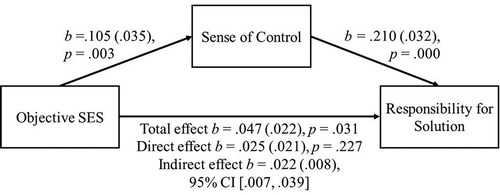
Figure 6. Subjective SES predict attribution for the locus of the problem cause through sense of control. Coefficients are shown with standard error in parentheses. Percentile bootstrapped 95% confidence intervals for the direct effect are indicated in brackets. Coefficients are significant if p < .05.
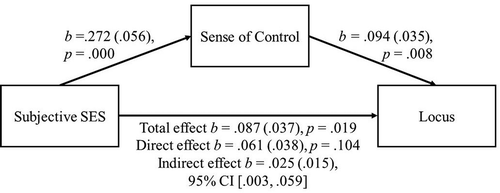
Figure 7. Subjective SES predict attribution for the perceived stability of the problem cause through sense of control. Coefficients are shown with standard error in parentheses. Percentile bootstrapped 95% confidence intervals for the direct effect are indicated in brackets. Coefficients are significant if p < .05.
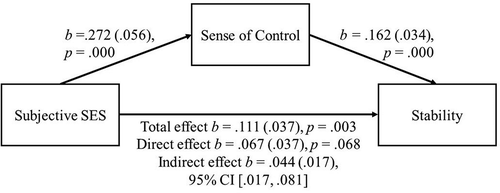
Figure 8. Subjective SES predict attribution for the perceived controllability of the problem cause through sense of control. Coefficients are shown with standard error in parentheses. Percentile bootstrapped 95% confidence intervals for the direct effect are indicated in brackets. Coefficients are significant if p < .05.

Figure 9. Subjective SES predict attribution for the perceived responsibility for the solution through sense of control. Coefficients are shown with standard error in parentheses. Percentile bootstrapped 95% confidence intervals for the direct effect are indicated in brackets. Coefficients are significant if p < .05
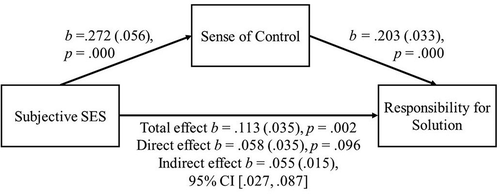
Based on the total effects, objective SES significantly positively predicted attributions of locus (Figure ) and responsibility for solution (Figure ) and marginally positively predicted attribution of stability (Figure ). It did not significantly predict attribution of controllability (Figure ). After accounting for sense of control, the direct effects of objective SES on attributions became nonsignificant. A similar pattern of results was found with subjective SES (Figures –). Total effects of subjective SES on the four attribution variables were all significant. Upon adding sense of control to the model, the direct effect of subjective SES on attributions became nonsignificant. Consistent with hypothesis 3, indirect effects statistics indicate that objective and subjective SES predict attributions through sense of control. Objective SES had significant positive indirect effect on attributions of locus (b = .011, p = .006), stability (b = .018, p = .007), controllability (b = .021, p = .008), and responsibility for solution (b = .022, p = .008). Similarly, subjective SES had significant positive indirect effect on all attribution variables (locus: b = .025, p = .015; stability: b = .044, p = .017; controllability: b = .053, p = .018; and responsibility for solution: b = .055, p = .015).
These results indicate that higher SES individuals generally feel that they have control over their life circumstances. With this elevated sense of control, when faced with a problem, higher SES individuals tend to attribute the cause to more internal, controllable and more changeable (or unstable) causes. They also tend to expect themselves (instead of others) to be responsible for finding a solution. There was no evidence that SES influence attributions regarding problem situations independent of its effect on the individual’s general sense of control.
6. Discussion
Social class and SES have long been recognized in the social sciences as an important factor in human development, and in recent years there has been growing interest in understanding how SES shapes individual psychological experience (Kraus & Stephens, Citation2012). Using the social cognitive perspective on social class (Kraus et al., Citation2012), the current study focused on how perception of problem situations can differ based on one’s socioeconomic status. Unlike previous research on the social cognitive perspective, the current study focused on perceptions that do not involve interpersonal or social phenomenon, and instead focused on problems that are personally experienced by the individual. The findings indicate that SES relates to individual differences in sense of control, and indirectly to how individuals make attributions of problems they may encounter.
The results provide further empirical evidence for the social cognitive perspective on social class proposed by Kraus et al. (Citation2012). So far, the theory has been used to look at how people perceive general social situations concerning other people and that do not necessarily apply to them (e.g. economic inequality; Kraus et al., Citation2009). The current study provides new evidence on SES differences in how individuals perceive day-to-day problem situations that are relevant to and that personally concern them. The findings extend the range of basic social cognitive processes that seem to be shaped by SES experiences, particularly to social cognitive processes that do not involve interpersonal or social phenomenon. Thus, the findings indicate that the social cognitive tendencies that characterize different SES groups are not only relevant to social perceptions and judgments involving other persons or groups; instead the tendencies also apply to when one is thinking about personal experiences.
The results also provide evidence for how sense of control may be a possible mediating psychological mechanism that relates to differences in problem attributions. In particular, the results show that differences in problem attributions are associated with differences in sense of control that relate to SES. Previous research shows that growing in an environment in which one’s needs are readily available or provided, one may develop a greater sense of control (Kraus et al., Citation2012). The current study provides further evidence for this proposition, but more importantly, the findings indicate that higher sense of control among those who report higher SES relates to perceptions of problems as having more personal, stable, and controllable dimensions. Considering one of the vignettes used in the current study, it seems that because of their higher sense of control, higher SES students who fail in an exam may reflect on their own actions and characteristics as the possible cause of the failure and that changing and controlling the cause and finding a solution is up to them. In contrast, students from lower SES who tend to have lower sense of control, may tend to think that the problem lies in the limited time given by the teacher and the workload assigned by their parents that are beyond their control, and that the solution to the problem is also not primarily their responsibility.
The differences in the attributions of higher class and lower class individuals found in the present study also has possible implications on the theory on self-serving bias (Heider, Citation1958). According to this theory, people tend avoid blame over problem situations in order to maintain a positive self-image. This, however, were not observed among higher SES participants. Instead, they were more likely to assign responsibility for the cause and solution to the self. The current findings suggest that attributional biases are not uniformly expressed or exhibited by everyone. Similar to previous findings that self-serving bias is less observable among non-Western cultures (Mezulis et al., Citation2004), the results of the present investigation points to SES as possibly another important factor to be considered in understanding how people make attributions. As self-serving bias was not measured in the current study, future studies can incorporate such measure to verify this explanation.
We note that the mediated or indirect effects associating SES with sense of control and problem attributions are mostly small but significant. Thus, we should caution against overstating the extent to which individuals from high and low SES differ in their problem attribution and in their sense of control. Indeed, the results should not be interpreted to suggest that higher SES individuals only see internal causes for problems or that lower SES individuals always blame others for their problems, or that lower SES individuals never see themselves as responsible for solving their problems. Rather, the results may indicate a difference in focus, in what is more salient to them, and in what more easily comes to mind; and that what becomes more salient to people is related to their general sense of control, the development of which is partly influenced by one’s life experiences given the individual’s SES (Kraus et al., Citation2012) and other social structural factors (Ross & Mirowsky, Citation2013). Previous research has established the important role of sense of control in various facets of physical wellness (Child, Stewart, & Moore, Citation2017; Oi & Alwin, Citation2017) and psychological well-being (Chipperfield, Hamm, Perry, & Ruthig, Citation2017), and even in social and intergroup processes (Fritsche et al., Citation2017; Jang et al., Citation2008). Future research could inquire into other SES differences that could actually be mediated by sense of control, as this might be one of the more fundamental differences that arise from the distinct SES environments and experiences.
Our results also provide further evidence that the objective and subjective measures of SES have similar yet still unique influence (Adler et al., Citation2000). The differences in the indirect effects of subjective and objective SES on the various problem attribution measures are small, but the subjective SES measures seem to be more strongly associated with sense of control, which seems to be consistent with the idea that the subjective experiences of having more or having less compared to other people may have a more important influence on social cognitive differences related to SES. This might not be the case if the SES differences relate to other outcomes that relate to more neuropsychological and physiological mechanisms. Thus, it is still important for researchers studying SES to distinguish the objective and subjective measures, and even consider other dimensions of the subjective measures such as SES identification (Rubin & Stuart, Citation2017). These measures of SES should be considered and analyzed separately depending on the focus of the SES differences in the research. But subjective rank measures of SES do seem to be particularly important when studying social cognitive differences.
But the study’s contributions to the social psychological literature should be viewed with reference to some important limitations of the study. We earlier noted the small indirect effect sizes, which suggests that the results should be further replicated and other possible mediators (and moderators) that could provide a more complete account of the indirect effect of SES on problem attributions should be studied in future research. The results are also derived from university student samples who ranked themselves near the middle range of the SES ladder. Although the effects are observed within this range, the model might be better tested with a more diverse set of participants from the community who represent a wider range of socioeconomic ranks. The measurement of attributions was limited to five varied situations selected for their relevance to the target population and results maybe specific to these problems. Future studies can test for other problem situations and explore other means of measuring attributions. These limitations of the study notwithstanding, the results provide further evidence that SES differences is not only experienced directly through material abundance or deprivation, but also through differences in the social context in which individual’s conceptions of the self and sense of control develop, which influence how problems and life’s challenges are perceived.
Acknowledgments
We acknowledge the valuable assistance provided by Helen Liu You Wen, Hazel Huang Yin, and Kevin Iam Man Chio in the preparation of the research materials.
Additional information
Funding
Notes on contributors
Mary Angeline A. Daganzo
Mary Angeline A. Daganzo is a PhD candidate at the Department of Psychology, Faculty of Social Sciences, University of Macau, Macau SAR, China. Her current research program focuses on the role of socioeconomic factors in adolescent development. This study is part of her PhD project investigating socioeconomic differences in helping behavior among adolescents and the underlying social cognitive mechanisms of such socioeconomic differences.
Allan B. I. Bernardo
Allan B. I. Bernardo is Professor of Psychology at the University of Macau, and is the PhD supervisor of Ms. Daganzo. He completed his PhD from Yale University, and one of the themes in his research program relates to socioeconomic inequality, socioeconomic mobility, and socioeconomic differences related to social cognitive processes.
References
- Adler, N. E., Epel, E. S., Castellazzo, G., & Ickovics, J. R. (2000). Relationship of subjective and objective social status with psychological and physiological functioning: Preliminary data in healthy, White women. Health Psychology, 19(6), 586–592. doi:10.1037/0278-6133.19.6.586
- Bosco, F. A., Aguinis, H., Singh, K., Field, J. G., & Pierce, C. A. (2015). Correlational effect size benchmarks. Journal of Applied Psychology, 100(2), 431–449. doi:10.1037/a0038047
- Bradly, R. H., & Corwyn, R. (2002). Socioeconomic status and child development. Annual Review of Psychology, 53, 371–399. doi:10.1146/annurev.psych.53.100901.135233
- Brickman, P., Rabinowitz, V. C., Karuza, J., Coates, D., Cohn, E., & Kidder, L. (1982). Models of helping and coping. American Psychologist, 37(4), 368–384. doi:10.1037/0003-066X.37.4.368
- Brislin, R. W. (1986). The wording and translation of research instruments. In W. L. Lonner & J. W. Berry (Eds.), Field methods in cross-cultural research (pp. 137–164). Newbury Park, CA: Sage.
- Child, S., Stewart, S., & Moore, S. (2017). Perceived control moderates the relationship between social capital and binge drinking: Longitudinal findings from the Montreal Neighborhood Networks and Health Aging (MoNNET-HA) panel. Annals of Epidemiology, 27(2), 128–134. doi:10.1016/j.annepidem.2016.11.010
- Chipperfield, J. G., Hamm, J. M., Perry, R. P., & Ruthig, J. C. (2017). Perspectives on studying perceived control in the twenty-first century. In M. D. Robinson & M. Eid (Eds.), The happy mind: Cognitive contributions to well-being (pp. 215–233). Cham, Switzerland: Springer.
- Davies, S., & Guppy, N. (2013). The schooled society: An introduction to the sociology of education. Toronto, ON: Oxford University Press.
- DiMaggio, P. (2012). Sociological perspectives on the face-to-face enactment of class distinction. In S. T. Fiske & H. R. Markus (Eds.), Facing social class: How societal rank influences interaction (pp. 15–38). New York: Russell Sage Foundation.
- Field, A. (2018). Discovering statistics using IBM SPSS statistics. Thousand Oaks, CA: Sage.
- Fritsche, I., Moya, M., Bukowski, M., Jugert, P., Lemus, S., Decker, O., … Navarro‐Carrillo, G. (2017). The great recession and group‐based control: Converting personal helplessness into social class in‐group trust and collective action. Journal of Social Issues, 73(1), 117–137. doi:10.1111/josi.12207
- Grossman, I., & Varnum, M. E. W. (2010). Social class, culture, and cognition. Social Psychological and Personality Science, 2, 81–89. doi:10.1177/1948550610377119
- Hayes, A. F. (2013). An introduction to mediation, moderation, and conditional process analysis: A regression-based approach. New York, NY: The Guilford Press.
- Heider, F. (1958). The psychology of interpersonal relations. Hoboken, NJ: John Wiley & Sons.
- Jang, Y., Chiriboga, D. A., & Small, B. J. (2008). Perceived discrimination and psychological wellbeing: The mediating and moderating role of sense of control. International Journal of Aging and Human Development, 66(3), 213–227. doi:10.2190/AG.66.3.c
- Jones, E. E., & Nisbett, R. E. (1972). The actor and the observer: Divergent perceptions of the causes of behaviour. In E. E. Jones, D. E. Kanouse, H. H. Kelley, R. E. Nisbett, S. Valins, & B. Weiner (Eds.), Attribution: Perceiving the causes of behaviour (pp. 79–94). Morristown, NJ: General Learning Press.
- Kraus, M. W., Horberg, E. J., Goetz, J. L., & Keltner, D. (2011). Social class rank, threat vigiland, and hostile reactivity. Personality and Social Psychology Bulletin, 37(10), 1376–1388. doi:10.1177/0146167211410987
- Kraus, M. W., & Keltner, D. (2013). Social class rank, essentialism, and punitive judgment. Journal of Personality and Social Psychology, 105(2), 247–261. doi:10.1037/a0032895
- Kraus, M. W., Piff, P. K., & Keltner, D. (2009). Social class, sense of control, and social explanation. Journal of Personality and Social Psychology, 97(6), 992–1004. doi:10.1037/a0016357
- Kraus, M. W., Piff, P. K., & Keltner, D. (2011). Social class as culture: The convergence of resources and rank in the social realm. Current Directions in Psychological Science, 20(4), 246–250. doi:10.1177/0963721411414654
- Kraus, M. W., Piff, P. K., Mendoza-Denton, R., Rheinschmidt, M. L., & Keltner, D. (2012). Social class, solipsism, and contextualism: How the rich are different from the poor. Psychological Review, 119(3), 546–572. doi:10.1037/a0028756
- Kraus, M. W., & Stephens, N. M. (2012). A road map for an emerging psychology of social class. Social and Personality Psychology Compass, 6(9), 642–656. doi:10.1111/j.1751-9004.2012.00453.x
- Lachman, M. E., & Weaver, S. L. (1998). The sense of control as a moderator of social class differences in health and well-being. Journal of Personality and Social Psychology, 74(3), 763–773. doi:10.1037/0022-3514.74.3.763
- Lareau, A. (2002). Invisible inequality: Social class and childrearing in black families and white families. American Sociological Review, 67(5), 747–776. doi:10.2307/3088916
- Malle, B. F., Knobe, J. M., & Nelson, S. E. (2007). Actor-observer asymmetries in explanations of behavior: New answers to an old question. Journal of Personality and Social Psychology, 93(4), 491–514. doi:10.1037/0022-3514.93.4.491
- Mezulis, A. H., Abramson, L. Y., Hyde, J. S., & Hankin, B. L. (2004). Is there a universal positivity bias in attributions? A meta-analytic review of individual, developmental, and cultural differences in the self-serving attributional bias. Psychological Bulletin, 130(5), 711–747. doi:10.1037/0033-2909.130.5.711
- OECD. (2012). Programme for international student assessment 2009 technical report. Retrieved from 10.1787/9789264167872-en
- Oi, K., & Alwin, D. F. (2017). Children’s sense of control as a determinant of adult health: Causation, mediation, and spuriousness. Journal of Health and Social Behavior, 58(2), 198–216. doi:10.1177/0022146517692012
- Peterson, C., Semmel, A., von Baeyer, C., Abramson, L. Y., Metalsky, G. I., & Seligman, M. E. P. (1982). The attributional style questionnaire. Cognitive Therapy and Research, 6(3), 287–300. doi:10.1007/BF01173577
- Petri, H. L., & Govern, J. M. (2013). Motivation: Theory, research and application. Belmont, CA: Wadsworth.
- Pizarro Milian, R. (2016). Rethinking stratification in post-secondary education: Organizationally maintained inequality ( Unpublished doctoral dissertation). McMaster University, Ontario, Canada.
- Pizarro Milian, R., & Hicks, M. (2014). Ontario private career colleges: An exploratory analysis. Toronto, ON: Higher Education Quality Council of Ontario.
- Ross, C. E., & Mirowsky, J. (2013). The sense of personal control: Social structural causes and emotional consequences. In C. S. Aneshensel, J. C. Phelan, & A. Bierman (Eds.), Handbook of the sociology of mental health (pp. 379–402). Dordrecht, Netherlands: Springer.
- Rubin, M., & Stuart, R. (2017 June). Kill or cure? Different types of social class identification amplify and buffer the relation between social class and mental health. Journal of Social Psychology. Retreived from. doi: 10.1080/00224545.2017.1327405
- Russell, D. W., McAuley, E., & Tarico, V. (1987). Measuring causal attributions for success and failure: A comparison of methodologies for assessing causal dimensions. Journal of Personality and Social Psychology, 52(6), 1248–1257. doi:10.1037/0022-3514.52.6.1248
- Snibbe, A. C., & Markus, H. R. (2005). You can’t always get what you want: Educational attainment, agency, and choice. Journal of Personality and Social Psychology, 88(4), 703–720. doi:10.1037/0022-3514.88.4.703
- Tabachnick, B. G., & Fidell, L. S. (2001). Using multivariate statistics (4th ed.). Allyn and Bacon: Boston.
- Takemura, K., Hamamura, T., Guan, Y., & Suzuki, S. (2016). Contextual effect of wealth on independence: An examination through regional differences in China. Frontiers in Psychology, 7, 384. doi:10.3389/fpsyg.2016.00384
- Van Overwalle, F. (1989). Structure of freshmen’s causal attributions for exam performance. Journal of Educational Psychology, 81(3), 400–407. doi:10.1037/0022-0663.81.3.400
- Weiner, B. (2010). The development of an attribution-based theory of motivation: A history of ideas. Educational Psychologist, 45(1), 28–36. doi:10.1080/00461520903433596
- Zhou, Y., Cai, T., & Wang, D. (2016). Social segregation in Hong Kong’s schools: 2000-2012. Chinese Sociological Review, 48(3), 248–270. doi:10.1080/21620555.2016.1166340
